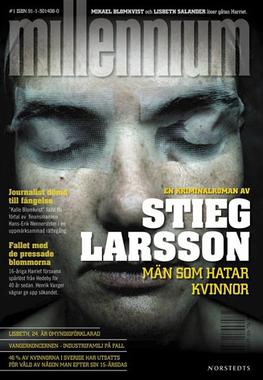The Girl with the Dragon Tattoo

The Girl with the Dragon Tattoo (original title in Swedish: Män som hatar kvinnor, lit. ’Men Who Hate Women’) is a psychological thriller novel by Swedish author and journalist Stieg Larsson (1954–2004), which was published posthumously in 2005 to become an international bestseller.[1] It is the first book of the Millennium series.
Larsson spoke of an incident which he said occurred when he was 15: he stood by as three men gang raped an acquaintance of his named Lisbeth. Days later, racked with guilt for having done nothing to help her, he begged her forgiveness—which she refused to grant. The incident, he said, haunted him for years afterward and in part inspired him to create a character named Lisbeth who was also a rape survivor.[2] The veracity of this story has been questioned since Larsson’s death, after a colleague from Expo magazine reported to Rolling Stone that Larsson had told him he had heard the story secondhand and retold it as his own.[3] The murder of Catrine da Costa was also an inspiration when he wrote the book.[4]
With the exception of the fictional Hedestad,[5] the novel takes place in actual Swedish towns. The magazine Millennium in the books has characteristics similar to that of Larsson’s magazine, Expo, such as its socio-political leanings and its financial difficulties.[6]
Both Larsson’s longtime partner Eva Gabrielsson and English translator Steven T. Murray have said that Christopher MacLehose (who works for British publisher Quercus) “needlessly prettified” the English translation; as such, Murray requested he be credited under the pseudonym “Reg Keeland”.[7] The English release also changed the title, even though Larsson specifically refused to allow the Swedish publisher to do so, and the size of Salander’s dragon tattoo; from a large piece covering her entire back, to a small shoulder tattoo.[8]
Every year for the past 36 years, Henrik Vanger receives an anonymous dried flower in a picture frame on November 1, his birthday. He has all of the frames displayed on a wall in his house. Every year, he phones his friend, a retired detective-superintendent, who shares his birthday and his age, and tells him about the latest flower. They can only wonder who sent it and why.
In December 2002, Mikael Blomkvist, publisher of the Swedish political magazine Millennium, loses a libel case involving allegations about billionaire industrialist Hans-Erik Wennerström. Blomkvist is sentenced to three months (deferred) in prison, and ordered to pay hefty damages and costs. Soon afterwards, he is invited to meet Henrik Vanger, the retired CEO of the Vanger Corporation, unaware that Vanger has checked into his personal and professional history; the investigation of Blomkvist’s circumstances has been carried out by Lisbeth Salander, a brilliant but deeply troubled researcher and computer hacker.
Vanger promises to provide Blomkvist with evidence against Wennerström in return for discovering what happened to Harriet Vanger, Henrik’s then-16-year-old niece and heir presumptive, who disappeared in 1966 during a family gathering at the Vanger estate on Hedeby Island the same day that a traffic accident on a bridge temporarily cut off the island from the mainland. Vanger has spent much of the intervening 36 years ruminating on the incident, and has concluded that she was murdered, as the lack of corpse rules out natural accidents and Harriet had (to Vanger’s knowledge) no means of escape. Blomkvist stays on the island while researching the Vanger family history and Harriet’s disappearance. He meets several members of the Vanger clan, including Harriet’s brother, Martin, current CEO of the company; Isabella, Martin and Harriet’s mother; and Cecilia, a headmistress who was Harriet’s first cousin once removed and friend, who seduces Blomkvist later in the novel.
